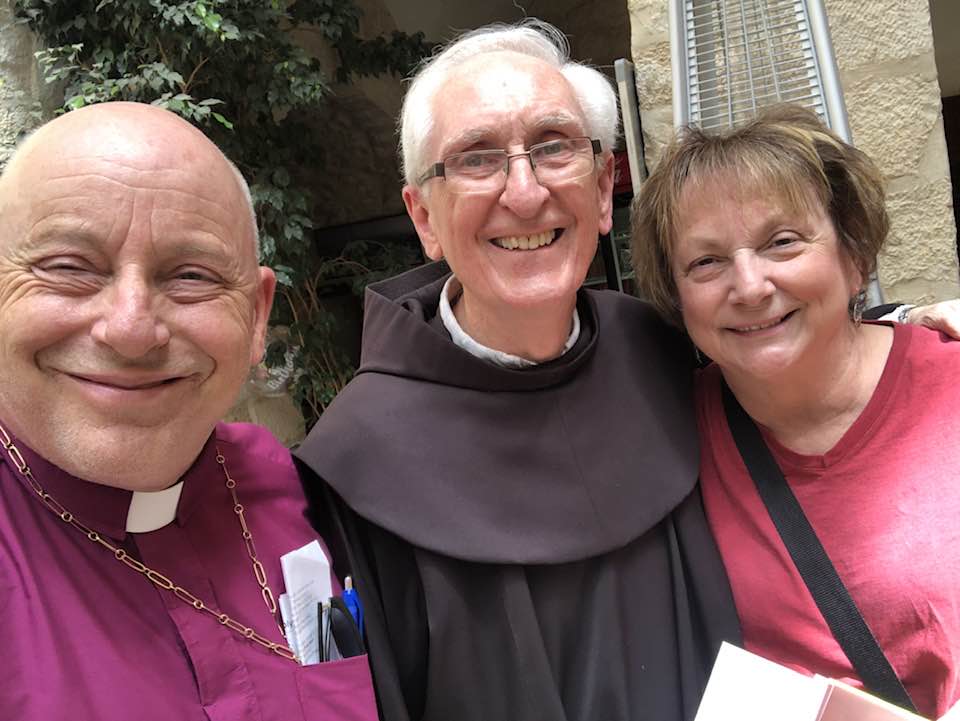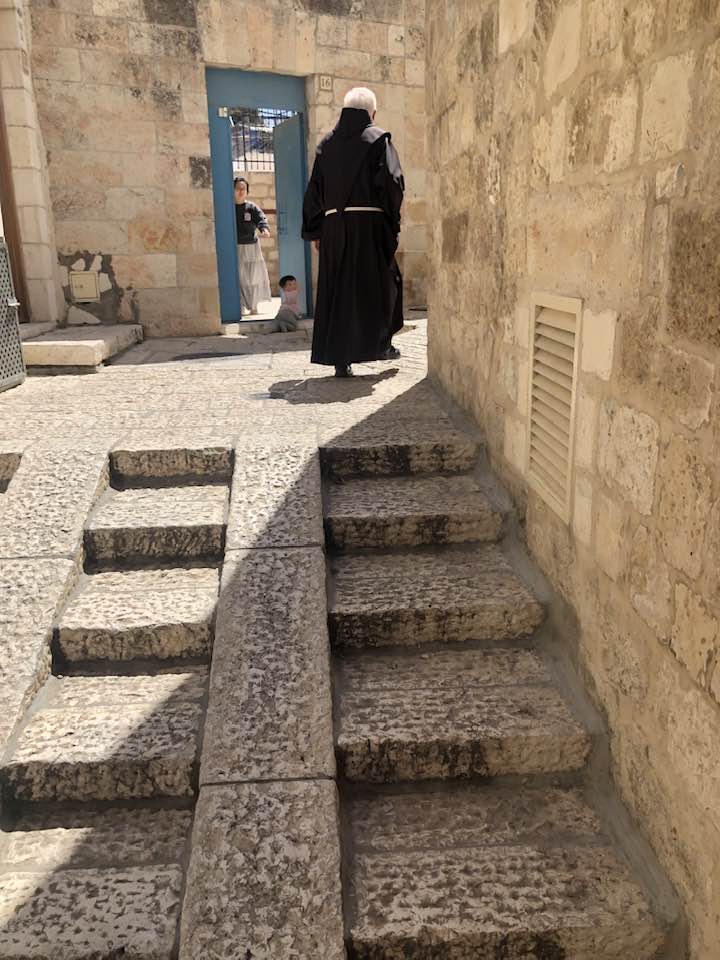
Fr. Fergus Clarke, a Jerusalem-based Franciscan friar, likes to say that he has a bone to pick with my old boss, Richard Nixon. He did it yet again on Tuesday, speaking to us 25 Episcopal Diocese of Los Angeles pilgrims over lunch in the Old City of Jerusalem.
What bugs him was 37 calling Apollo XI, which resulted in the first moon landing in July 1969, the greatest event since the creation. Nothing doing, says Fergus. That status belongs to the three days of our Lord’s passion and resurrection. The focal point of these events is Fergus’s greatest love besides his risen savior, the Church of the Holy Sepulcher. Built where Queen Helena, Constantine’s mother, is said to have found Jesus’s cross, the church encloses the traditional sites of the crucifixion and resurrection.
Fergus’s Jerusalem love story has a local angle. For eight years, the Ireland-born priest was pastor at St. Joseph’s Roman Catholic Church in Placentia. There he became friends with Charles Frazee, a formerly practicing Catholic priest, the longtime church history professor at Bloy House, and my friend until his death in 2019. Charlie loved to read scripture during mass and teach about church history. Fergus and Charlie became fast friends.
 Almost 15 years ago, Charlie was matchmaker for Fergus, pilgrim Kathy Hannigan O’Connor, and me. It was the Holy Spirit who matched Fergus to the world’s greatest church. He had a powerful epiphany in 1995 while on a spiritual retreat in Jerusalem, feeling called to be one of the Franciscan friars who look after Holy Land sites. He and his superiors resisted, but to no avail. Soon it was goodbye, Placentia. Three stints living in the Holy Sepulcher followed, praying the sacred offices starting each day at 4 a.m., playing the organ, and dealing with the politics of a church with no congregation (besides the human race), run by six denominations who agree on relatively little. He also oversaw the design and construction of a new basilica at the Franciscan site on Mt. Nebo in Jordan.
Almost 15 years ago, Charlie was matchmaker for Fergus, pilgrim Kathy Hannigan O’Connor, and me. It was the Holy Spirit who matched Fergus to the world’s greatest church. He had a powerful epiphany in 1995 while on a spiritual retreat in Jerusalem, feeling called to be one of the Franciscan friars who look after Holy Land sites. He and his superiors resisted, but to no avail. Soon it was goodbye, Placentia. Three stints living in the Holy Sepulcher followed, praying the sacred offices starting each day at 4 a.m., playing the organ, and dealing with the politics of a church with no congregation (besides the human race), run by six denominations who agree on relatively little. He also oversaw the design and construction of a new basilica at the Franciscan site on Mt. Nebo in Jordan.
These days Fergus lives in the Custodia Terrae Sanctae, the Franciscan compound in the Old City, while still playing the organ at all hours in the Holy Sepulcher and serving as organist at St. Saviour, the Custody’s parish church. As he has before, he graciously accepted Kathy’s and my invitation to meet with our pilgrims, this time over a lunch at the Maronite Guest House.
As he always does, Fergus brought the resurrection power. He beats it like a drum, and you always leave him with your heart pounding a little harder. Pilgrimages can be a blur of bus rides and early-morning calls, trying to keep two dozen churches straight, eating too much pita and hummus, aching feet, shopping, and remembering to pay ten shekels for your Coke Zero. Amid all that, Fergus wants pilgrims to go home remembering that on the third day after his crucifixion, right there, in defiance of earthly logic and reason, our Lord Jesus Christ got up off his slab in his sketchy tomb outside the city walls (and so the church then was, archaeologists have decided), poked his head through the door, and felt the sun on his face again.
When God did this, Fergus says, God destroyed the power of death and made all things new, except the church which shows where it happened. Fussy Anglicans came to Jerusalem late in the 19th century and decided the Holy Sepulcher was too dirty, chaotic, and disputatious to be holy. Many have fixed on the genteel Garden Tomb instead. It’s a sweet place, but give me the Holy Sepulcher. God is many things but never genteel.
 Fergus and his fellow Franciscans and their Greek Orthodox counterparts sometimes do clash over running the church. Pilgrims famously complain about the Greek monks, who tend to be bossy at Christ’s tomb. As Fergus says, they should be excused for taking with the utmost seriousness their stewardship of the only place in the universe where, for one moment, in the life of Jesus of Nazareth and for the sake of the whole world, God suspended the laws of biology and physics. Do not take a picture, the monks say. Kneel in silent awe.
Fergus and his fellow Franciscans and their Greek Orthodox counterparts sometimes do clash over running the church. Pilgrims famously complain about the Greek monks, who tend to be bossy at Christ’s tomb. As Fergus says, they should be excused for taking with the utmost seriousness their stewardship of the only place in the universe where, for one moment, in the life of Jesus of Nazareth and for the sake of the whole world, God suspended the laws of biology and physics. Do not take a picture, the monks say. Kneel in silent awe.
We take all this on faith, of course. Not every Christian confesses a belief in the bodily resurrection. It’s not a requirement for admission. And yet the power of memory the church signifies is arresting. When the Edicule was restored six years ago, experts got a rare look at what is taken to be the original cave and slab comprising Jesus’s tomb. How do we know? Why did Helena build her church there? Because indigenous Christians told her they remembered, despite Rome trying to stamp it all out beginning in A.D. 135. Helena caught the bug in the fourth century. Fergus caught it in 1995. “It’s the only church in the world where multiple denominations worship in their own way in the same place at the same time,” he said. “What makes that miracle happen is faith in the resurrection.”
The world needs the miracle now more than ever, as another of Mr. Nixon’s slogans went. We pilgrims flew home Friday, some having also caught a Holy Land bug, namely COVID, but none with serious symptoms, thanks be to God. It’s of course the same world we left. Though Mary Magdalene was the apostle to the apostles, telling the good news to frightened men, hundreds of millions of women around the world still aren’t free, and in places like Afghanistan, it’s getting worse. Though indigenous Christians told Helena and Rome the good news, millions of their east Jerusalem and West Bank successors are still disenfranchised, victims of an indefinitely stalled peace process.
 Everywhere we look, battle lines are hardening. We returned to a nation still at war with its pluralistic destiny, still fearing what will happen if everyone’s voice is truly heard. Trans children and immigrants of color are just the latest scapegoats. The planet is fighting for its life. Ukraine is fighting for its life. Taiwan may soon have to as well. Freedom and justice are on the run in the 21st century.
Everywhere we look, battle lines are hardening. We returned to a nation still at war with its pluralistic destiny, still fearing what will happen if everyone’s voice is truly heard. Trans children and immigrants of color are just the latest scapegoats. The planet is fighting for its life. Ukraine is fighting for its life. Taiwan may soon have to as well. Freedom and justice are on the run in the 21st century.
With all that, after the achingly slow progress toward a better world these last 20 centuries, resurrection enables us to listen attentively to and make room for every voice and story. To say to someone who is suffering, who has lost a child, who has been hurt for any reason, by any illness, loss, or injustice, that it’s going to be okay — eventually, somehow, it’s going to okay.
No secular philosophy enables us to make that promise and mean it, especially about things that have no earthly way of being okay anytime soon. But by faith, by the light of the empty tomb, not only can we say it, but we can find the courage to take the risk of trying to make things better so our promise will come true. Sorry, Mr. Nixon, but Fergus gets it right every time. The greatest event since the creation signified creation’s benevolent purposes and every creature’s as well — to glorify God, care for God’s people, and take comfort and joy in our eternal membership in God’s family circle of deathless love.
